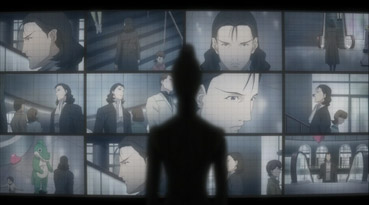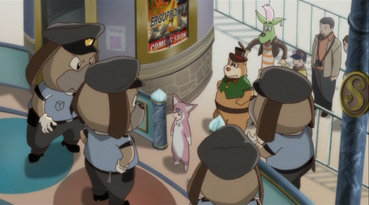|
I remember reading early in my appreciation of this excellent anime series that there was some fan disappointment at the final episodes. At the time I chose to ignore this – when a series is firing on all cylinders it's hard to believe it'll ever do otherwise, and when it's taking the sort of chances that Ergo Proxy has with narrative and character, the very idea that it might compromise seems absurd. Volume 4 in particular was a scorching example of the series at its experimental and artistic best, so hopes were high for Volume 5, at least in this quarter. And there's fine stuff here, make no mistake, but for the very first time, Ergo Proxy has shown signs that it might actually stumble.
As before, I'm assuming that if you're reading this you've seen the previous volumes. If you haven't but want to read on regardless, the reviews of Volume 1, Volume 2, Volume 3 and Volume 4 will at least help some of the following to make sense.
Volume 5 kicks off with Episode 17, Terra Incognita, which abandons the semi-experimental approach of the previous volume for a return to a more formal narrative structure, dual stories that are cross-cut with each other that at one point almost overlap. As Re-l, Vincent and Pino continue their journey to Mosk Dome, Romdo security chief Raul Creed develops a serious bee in his bonnet about Vincent, whom he blames for the city's present woes and becomes so obsessed with wiping out that he starts having visions of him everywhere. Stripped of his post and facing revocation of his citizenship, Creed goes on the run and for a short while actually becomes more interesting than the three renegades.

Both stories continue intriguingly in Episode 18, Life After God, but each have their disappointments, with both the resolution of Creed's adventures and a new direction for the travellers that has just a whiff of storytelling safety-play. To reveal details of either plot would spoil things for series regulars.
In Episode 19, Eternal Smile, the series throws another of its always welcome curve-balls as Pino awakes to find herself in a giant amusement park known as Smile Land, which is populated almost exclusively by Warner Brothers-style cartoon characters, complete with exaggerated expressions, wacky sound effects and visual representations of extreme sensations (twittering birds circling heads when dazed, etc.). They're all under the loose control of the park's creator and, it is suggested, their own animator, a man named Will B. Good (you heard me), who's an absolute dead ringer for Walt Disney and is stalled on his latest film project, Attack of the Ergoproxy!!. The artists and animators clearly had fun with this one, and it plays out most engagingly and a little self-reflectively, with the character of Rogi the Cricket complaining that the story won't go anywhere if Pino keeps adding complications and that they'll have to skip the big twist and go straight to the resolution. If the final act explanation seems a little weak (although its context is interesting – sorry, but I can't be more specific without spoiling things) then the fairytale ending does tend to compensate, at least until the end of...
Episode 20, Goodbye Vincent, puts the series back into minor mindfuck territory, as Vincent finds himself passively trapped inside the body of an unaware Re-l, who appears to be back in Romdo but minus her two previous companions. Vincent's presence is identified by Re-l's mental counsellor Sam, who is keen to convince him that he's not Vincent at all but a product of Re-l's own split personality. To go any further with explanations would ruin the fun, as the series once again dives headlong into the philosophy of identity and the self in pleasingly challenging fashion. All of which is undercut by the ending. Now I'm not going to reveal it here but I will say that it pissed me off, not just because the explanation it provides is an unsatisfying twist-ending cliché, but also because it's the almost exact same one used in the previous episode, adding to the sense that by this stage the ideas bank was starting to run dry.

If you've come this far with the series then there's no turning back and maybe you'll be more forgiving than me. There's still plenty to admire and be gripped by here, with the character and background artwork as strong as ever and the stories peppered with beguiling small detail (when Pino's batteries begin to run down, for example, she has to be carried like the small child she is designed to emulate, and the method used to track Creed when he goes on the run is a most believable extension of existing technology). We're now just three episodes from the end – I await with interest and no small measure of hope to see if this otherwise superb anime series delivers on its previous promise for the finale.
The episodes included here are (alternative titles in brackets): Terra Incognita (Never-ending battle), Life After God (Sign of the End), Eternal Smile (The Girl With a Smile) and Goodbye Vincent (Sacred Eye of the Void).
There's little to add to the previous evaluations of the picture and sound quality, which has not changed from earlier volumes and copes well with the show's dark look with no obvious compression issues. The brighter imagery of Eternal Smile is also reproduced cleanly. As ever the transfer is 1.78:1 and anamorphically enhanced.
The same trio of soundtracks as before are on offer and of the usual quality, with no obvious differences between the Japanese 5.1 track and the English 5.1 and DTS tracks. My preference for the Japanese track remains, especially when dealing with the character of Pino, who on the original sounds like the young girl she's supposed to be but on the English language track sounds like an adult woman pretending to be a kid, which breaks the spell completely.
Still the weak point of the Ergo Proxy DVDs, save for the first one, are their lack of extra features, unless you count promos for other MVM releases Witchblade and Trinity Blood, and I don't.
It's still good, very good as it happens, but a couple of cop-out decisions in the storytelling mean that Volume 5 falls a little short of the standard set by its predecessors. If you're a series fan then you'll want to see the latest four episodes anyway, and see them you should – just prepared to go "oh come on..." at least once during that 103 minutes.
|